Gotlandsdricke - an overview
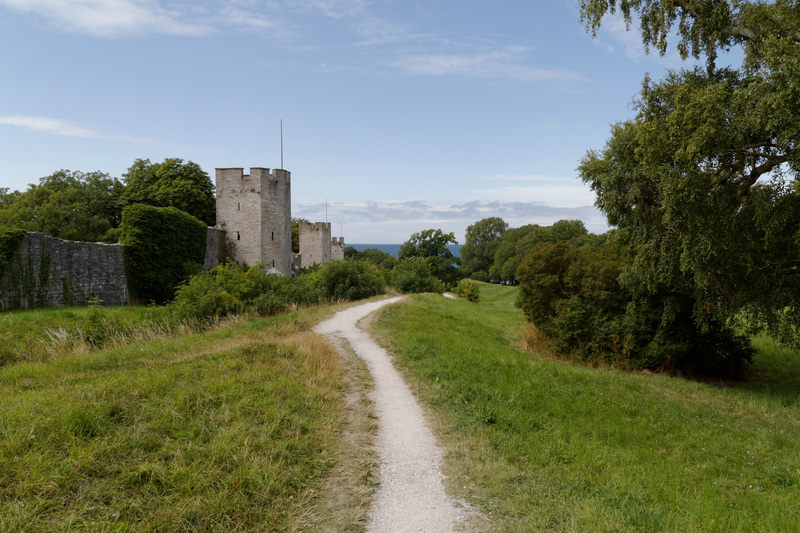
Visby city walls |
A lot has been written on Gotlandsdricka, but the writers generally call it "an ancient beer" or "indigenous beer" and variations on that theme. Nobody seems to have realized that it is of course a farmhouse ale. Farmhouse ale was made all over Sweden until it was replaced by modern commercial beer. Except on Gotland, where the farmers never stopped brewing it. Eventually it came to be seen as something unique to Gotland and part of the Gotland identity, but that's a recent development.
How this came to be is no mystery at all. Gotland fits perfectly with the criterion for a place where farmhouse brewing survived: "isolated farming community with good-sized population." Gotland is three hours by ferry from the mainland, has lots of agriculture in the southern part of the island, and a population of about 60,000.
Gotland is actually an interesting place in other ways, too. In many ways it's the crossroads of the Baltic, nearly as close to Latvia and the Estonian islands as to Sweden. Gotland has been a hotspot for trade since at least 1000 BCE. In the viking period the Gotland traders had trading offices in London and Novgorod, and their hoards of silver coins are still being dug out of the ground in Gotland. The Havor find of a Roman wine set from the first centuries CE is another example of Gotland being well connected by trade.
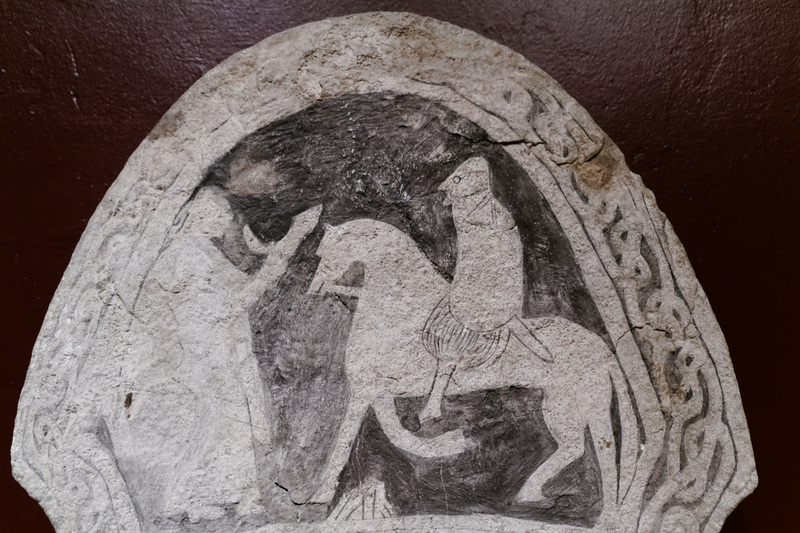
Picture stone, showing a rider offered a horn of drink, Gotlands Fornsal |
Traditionally, people were farmers all over Gotland itself and the smaller Fårö just north of Gotland. Anyone who's ever been to Fårö could be forgiven for doubting this, because there's barely any soil on Fårö. The farmers there burned kelp, and strewed it on the stones. That was enough for them to be able to grow rye, which to astonished visitors seemed to sprout right out of the stones.
Fårö and northern Gotland are not very fertile, and in the late 19th century limestone quarrying and burning became a major industry there. That led to much of the farming being abandoned, and also caused workers to move to Gotland from the mainland. The effect was that the farmhouse brewing died out in the northern part of the island.
Originally, this was classic farmhouse brewing, with farmers malting their own grain, growing their own hops, and keeping their own yeast. Just like elsewhere, this pattern gradually broke up. According to Salomonsson[15], the last time he heard of "home yeast" ("hemjäst"), that is, kveik, was in 1973. As far as I know, the local yeast has now died out completely. Many people started buying their malts from the local brewery instead of making it, but that tradition still lives, as we've seen. And some still grow hops.
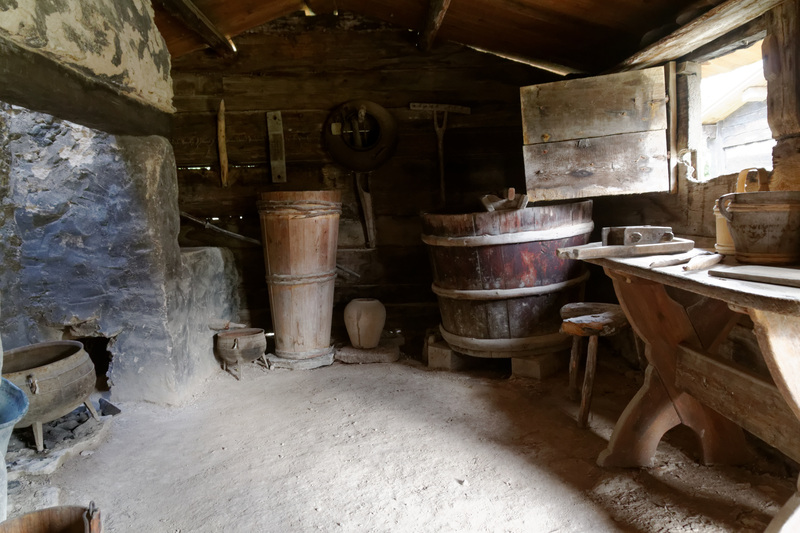
Old kitchen with brewing implements, Bunge county museum, Gotland |
Most published descriptions of gotlandsdricke just give a single recipe, citing no sources. Or they give a recipe that's altered to suit modern home brewers. That makes it very difficult to tell how accurate the descriptions are. And quite often the published accounts contradict each other. "The malts were smoked with beech wood," says one. "The malts were smoked with alder wood," says another. So what's correct? Time to turn to the recipe collection.
Below is a table of every single Gotland recipe I have, collected from all kinds of sources.
| No | Grain | Boil | Juniper | Infusion | Hops | Smoked |
|---|---|---|---|---|---|---|
| 1 | Rye, barley | Y | Y | N | Y | Y |
| 2 | ? | Short | Y | N | Y | ? |
| 3 | Barley | Y | Y | Y | Y | Y |
| 4 | Barley | N | Y | Y | Y | Y |
| 5 | ? | Y | Y | Y | Y | ? |
| 6 | Barley | Y | Y | Y | Y | N |
| 7 | Barley | Short | Y | Y | Y | ? |
| 8 | Barley | Y | Y | Y | Y | Y |
| 9 | Rye | Y | ? | ? | Y | ? |
| 10 | ? | Y | ? | ? | Y | ? |
| 11 | ? | N | Y | Y | Y | ? |
| 12 | ? | Y | N | N | Y | ? |
| 13 | ? | Y | Y | Y | Y | Y |
| 14 | Barley | Y/N | Y | Y | Y | Y |
Note that [9] is from Fårö, which explains the rye.
So, what can we learn from this? On Gotland itself, people seem to have preferred barley malts, and used rye only if they had to, which they very rarely did. Most people used smoked malts. Everyone used hops. Nearly everyone used juniper in the strainer, and most people also used juniper infusion. The juniper seems to be a major part of the character of the style, but as with Norwegian, Finnish, Estonian, and Latvian farmhouse ale we are talking about juniper branches.
As for boiling the wort, we have two accounts not doing it, two with short boils, and nine normal boils. So for the most part modern gotlandsdricke seems to have been boiled, but it's clearly been quite common not to boil as well. How recently boiling was introduced is impossible to tell from the sources I have.
Another question is the type of wood used to smoke the malts. This has a major impact on what smoke flavour you get. The data is very sparse, but we find: alder [4], birch [12], birch [16]. This is actually similar to the data for Sweden in general, and also Norway. So we can conclude both alder and birch were used on Gotland, and it wouldn't surprise me to also find pine and juniper. Beech probably wasn't used, because it doesn't grow naturally on the island.

Malt drying house, Bunge museum |
The most common malting method appears to have been pretty much the same as the Norwegian badstu (bath house/sauna), even if the building itself looked rather different. There is also the "loft kiln," which is a rack next to the chimney with perforated wooden planks. An older variation is the "floor kiln", which has the rack much closer to the fire, which means the maltster has to be very careful with the wood fire, and stir the malts frequently. So it seems smoked malts really was the norm on Gotland[17].
Other things we learn are that boiling the mash seems to be unknown, as does step mashing. No mention of baked malts or hot stones. However, one brewer apparently does an initial cold mash, where the ground malts are left in cold water over night before the mash is heated.
The strength of the beer is hard to judge, as always, but five recipes have 250g of malts per liter of beer, while one has 120g. Some of these ratios were with home-made malts, and quite a few also used sugar, which complicates the question of how strong the beer is. I don't have enough data on the efficiency of the traditional mashing methods to dare compute an ABV.
Today, fermentation times seem to be 5-7 days, which is probably longer than they were before, which again is likely to be due to the use of baking yeast rather than kveik (traditional yeast). The beer has very little carbonation, beyond what's produced by continued fermentation in the serving vessel.
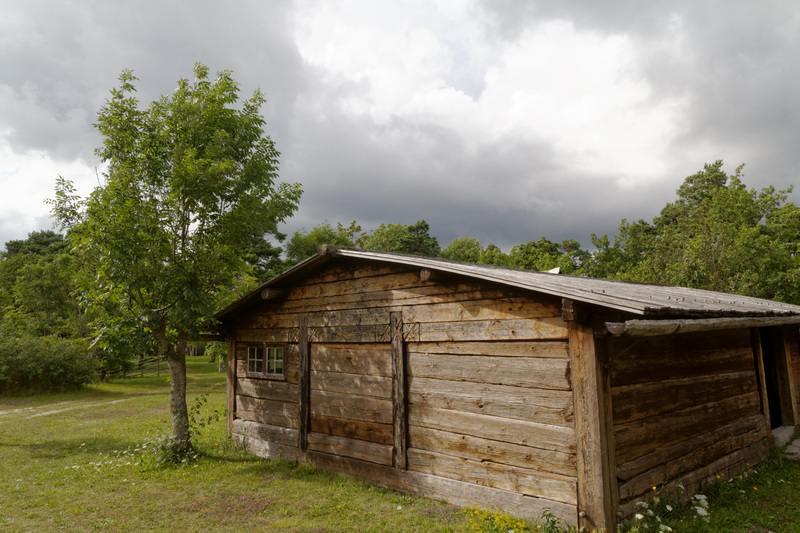
Reconstructed communal feasting hall, Bunge museum |
As far as the hopping goes, that's all over the place. One recipe has 4 grams/liter[4], one has 0.4 [7], and one has 0.05 [8]. The beer with the most hops was Anders Mattsson's, and that one I've actually tasted. There was no discernible hop character in it, probably because he boiled the hop tea in such a small volume of water. So I think overall it's probably safe to declare that like most farmhouse ale, Gotlandsdricke has very little if any hop taste.
Anyway, this is what I've been able to find out about Gotlandsdricke so far. It's definitely a low-carbonated, paleish, smoky farmhouse ale with juniper infusion from barley malts and very little hop character. I should have been able to collect more detail, and taste enough of them to make a proper style description, but that isn't possible yet. I'm hoping to eventually visit Gotland again and taste more examples.
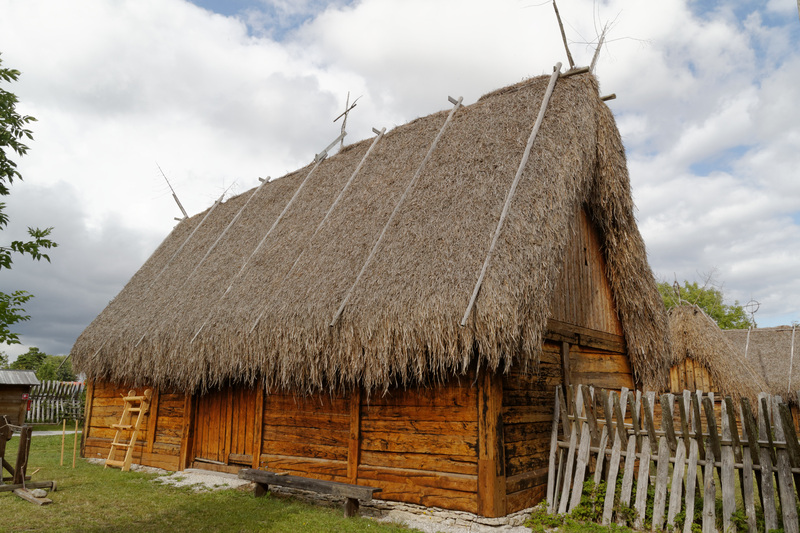
Old farmhouse, Bunge museum |
Sources
Much of the background in this blog post is taken from Anders Salomonsson's book[15] on Gotlandsdricke.
[1] Gotländska mattraditioner - Seder och bruk i helg och vardag, Ingeborg Lingegård, LTs forlag, 1978.
[2] Gotländska Mattraditioner från sekelskiftet 1800-1900, Britt Smitterberg, self-published manuscript, undated, Gotlands Fornsal.
[3] Hembryggd dricka från Gotland, Anders Salomonsson, typewritten manuscript, 326/77, Gotlands Fornsal.
[4] My own interview with Anders Mattson.
[5] Alle tiders øl, Per Kølster, Politikens forlag, Copenhagen, 2007. ISBN 9788756776165.
[6] Das Gotlandkuchboch - Eine Kleiner Führer durch Gotlands Küche, Michael Engelbrecht, unpublished manuscript, undated, Gotlands Fornsal.
[7] Anders Nilsson, Facebook post, 2014-04-13.
[8] Gotlandsdricka, the Ancient Brew of Gotland, Håkan Lundgren, Zymurgy 17, no 4, 1994.
[9] EU 7807, farmhouse ale questionnaire response from the ethnographic survey at the Nordic Museum, Stockholm., reproduced in De gamle göter drucko ur horn, B. G. Söderberg, in Gotländsk ölbrygd, Visby, 1960.
[10] EU 7779, from same.
[11] EU 8414, from same.
[12] Recipe by Wendla Wallin, from same.
[13] Recipe by Reddit user Error2k.
[14] The Goodland island and its ancient beers, Michael Jackson, What's Brewing, 1996-12-01.
[15] Gotlandsdricka, Anders Salomonsson, Skrifter utg. av Etnologiska sällskapet i Lund, Lund, 1979.
[16] My own interview with Staffan Larsson.
[17] Den gotländske kölnan, Anders Salomonsson, Gotländskt Arkiv, 1977.
Thanks to Geir Ove Grønmo, who bought the 1994 Zymurgy issue back when we were researching keptinis.
Similar posts
A brewer on Gotland
Last summer, the family holiday included a visit to Gotland
Read | 2016-12-27 13:09
A maltster on Gotland
While on holiday on Gotland I saw a note on a poster about an open farm and something about malt being made
Read | 2017-01-01 14:02
The juniper mystery
When I started looking at farmhouse ale back in 2010, one of the first things that struck me was that nearly everyone seemed to be using juniper
Read | 2017-02-02 09:43
Comments
Alec Latham - 2017-01-08 12:09:50
Another intriguing chapter into Scandinavian brewing history - as always. From what you mentioned about the badstu, it would be amazing if malt kilning culture and sauna culture were interwoven in the distant past of northern Europe.
Lars Marius Garshol - 2017-01-08 12:39:11
@Alec: It's entirely possible that they were. I still haven't finished researching this, but I think Ilmar Talve's massive tome on exactly this subject should have the answer.
Jeremiah Fiegl - 2017-01-08 21:09:13
If you are familiar with the 2015 BJCP guidelines, what beer would you classify the base beer as? I'm entering a competition as a Wild Specialty beer, but I'm at a loss for the base beer other than a spice and vegetable beer which would also require a base beer.
note: I fermented with 100% brett.
Lars Marius Garshol - 2017-01-14 06:14:20
@Jeremiah: I overlooked this comment. My apologies.
I don't understand your question. What do you mean "base beer"? The beer is gotlandsdricke. That's the style. It's not in BJCP, but that's their problem. It is in the newest Brewers Association styles, but they misunderstood a few things.
Piotr Nowicki - 2020-10-05 20:19:13
Hi, I've just found this article and I'm wondering if there is a specific brand of baker yeast that is recommended to get the most of the style? Do you think there is a yeast strain that could replace it, like Belgian, Weizen (like aromas that sahti produces)? Does it produce any specific aromas/flavours?
Thanks!